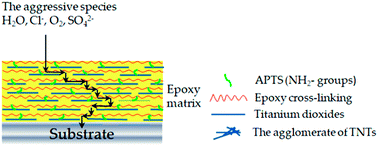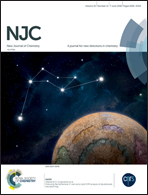Modification of TiO2 nanotubes with 3-aminopropyl triethoxysilane and its performances in nanocomposite coatings†
Abstract
Until now, mono-dispersion of nanofillers, such as TiO2 nanotubes, in a polymer matrix remained a major challenge in the preparation of polymer nanocomposites. To improve the dispersion capability of TiO2 nanofillers in the epoxy matrix, the surfaces of TiO2 nanotubes were successfully modified with 3-aminopropyl triethoxysilane (APTS) by a facile aqueous process. The weight loss of APTS-grafted TiO2 nanotubes could be attributed to three main contributions: dehydration of adsorbed water, physical adsorption of APTS and thermal decomposition of APTS chains. In addition, transmission electron microscopy (TEM) images of APTS-grafted TiO2 nanotubes further evidenced a tubular shape with no destruction before and after grafting treatment. Furthermore, the APTS-grafted TiO2 nanotubes were used as the white pigment for preparing the epoxy-based coatings. It was found that the amine group on nanotube surfaces, which mediated as a curing agent, coordinated with the epoxy group through covalent bonding, thus allowing improved composite formation between the nanotubes and the epoxy matrix. The effects of APTS-grafted TiO2 nanotubes on the mechanical, thermal and corrosion resistances of epoxy coatings were examined. From detailed mechanical characterizations, it was revealed that the performances of pull-off adhesion, impact resistance and bending resistance of the APTS-grafted TiO2 nanotubes/epoxy coatings were greatly improved compared with the unmodified TiO2-based coating with the same 5% additive content. In addition, the resulting thermal properties and corrosion resistances of the epoxy resin were significantly improved due to the enhanced reinforcement of APTS-grafted TiO2 nanotubes within the epoxy matrix.



 Please wait while we load your content...
Please wait while we load your content...